FORD GRANADA 1985 Service Repair Manual
Manufacturer: FORD, Model Year: 1985, Model line: GRANADA, Model: FORD GRANADA 1985Pages: 255, PDF Size: 14.98 MB
Page 101 of 255
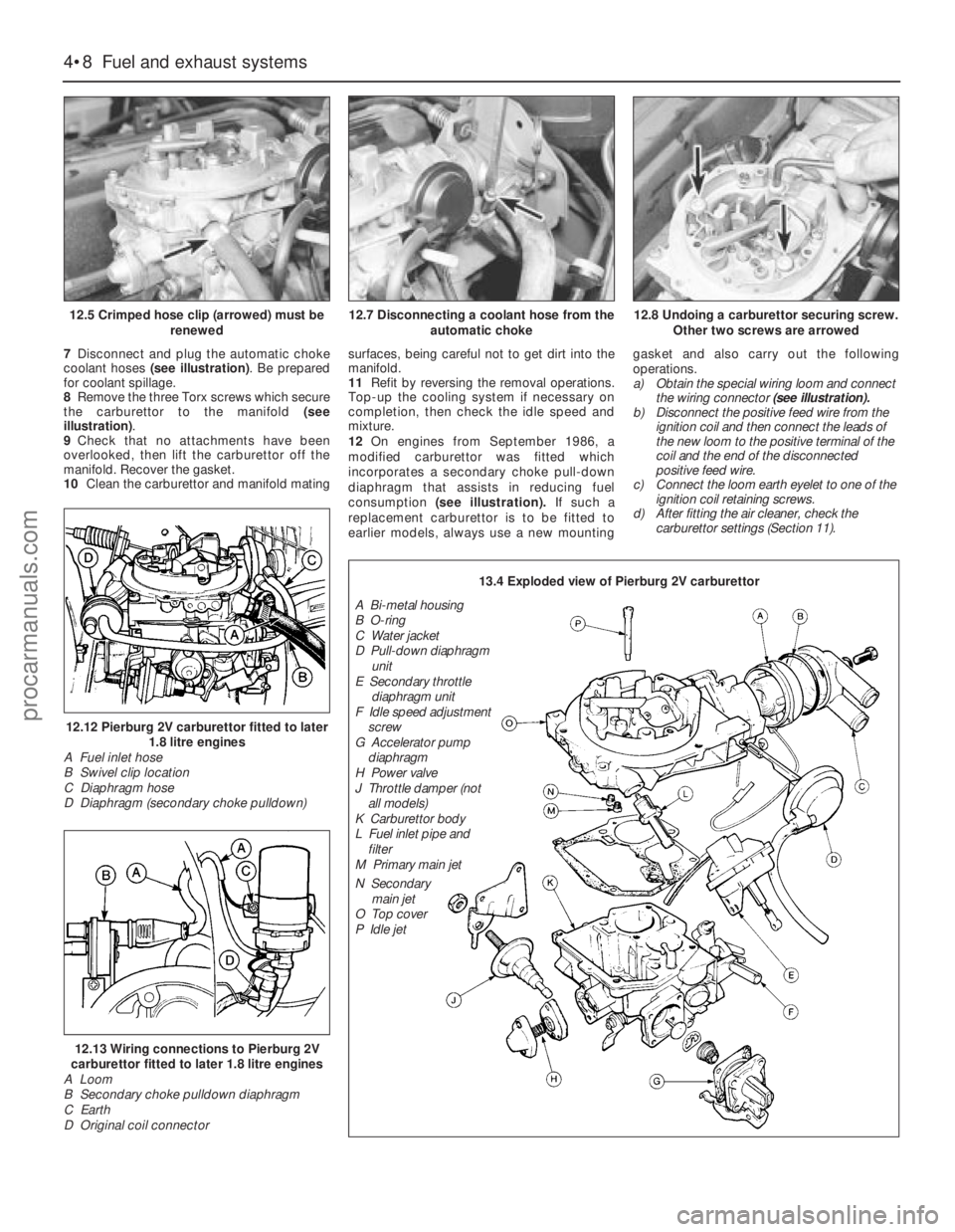
7Disconnect and plug the automatic choke
coolant hoses (see illustration). Be prepared
for coolant spillage.
8Remove the three Torx screws which secure
the carburettor to the manifold (see
illustration).
9Check that no attachments have been
overlooked, then lift the carburettor off the
manifold. Recover the gasket.
10Clean the carburettor and manifold matingsurfaces, being careful not to get dirt into the
manifold.
11Refit by reversing the removal operations.
Top-up the cooling system if necessary on
completion, then check the idle speed and
mixture.
12On engines from September 1986, a
modified carburettor was fitted which
incorporates a secondary choke pull-down
diaphragm that assists in reducing fuel
consumption (see illustration).If such a
replacement carburettor is to be fitted to
earlier models, always use a new mountinggasket and also carry out the following
operations.
a)Obtain the special wiring loom and connect
the wiring connector(see illustration).
b)Disconnect the positive feed wire from the
ignition coil and then connect the leads of
the new loom to the positive terminal of the
coil and the end of the disconnected
positive feed wire.
c)Connect the loom earth eyelet to one of the
ignition coil retaining screws.
d)After fitting the air cleaner, check the
carburettor settings (Section 11).
4•8Fuel and exhaust systems
12.5 Crimped hose clip (arrowed) must be
renewed
12.12 Pierburg 2V carburettor fitted to later
1.8 litre engines
A Fuel inlet hose
B Swivel clip location
C Diaphragm hose
D Diaphragm (secondary choke pulldown)
12.13 Wiring connections to Pierburg 2V
carburettor fitted to later 1.8 litre engines
A Loom
B Secondary choke pulldown diaphragm
C Earth
D Original coil connector
12.7 Disconnecting a coolant hose from the
automatic choke12.8 Undoing a carburettor securing screw.
Other two screws are arrowed
13.4 Exploded view of Pierburg 2V carburettor
A Bi-metal housing
B O-ring
C Water jacket
D Pull-down diaphragm
unit
E Secondary throttle
diaphragm unit
F Idle speed adjustment
screw
G Accelerator pump
diaphragm
H Power valve
J Throttle damper (not
all models)
K Carburettor body
L Fuel inlet pipe and
filter
M Primary main jet
N Secondary
main jet
O Top cover
P Idle jet
procarmanuals.com
Page 102 of 255
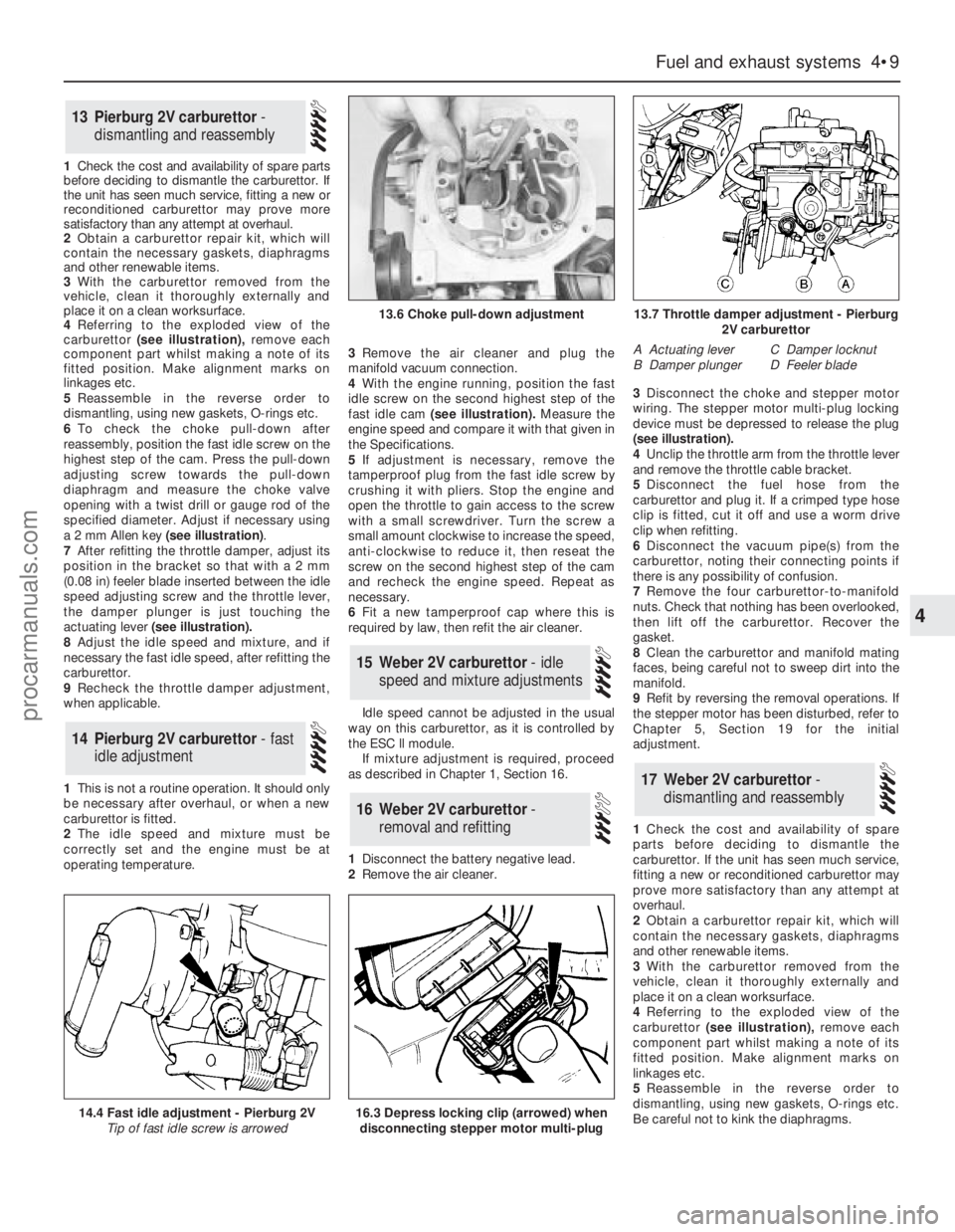
1Check the cost and availability of spare parts
before deciding to dismantle the carburettor. If
the unit has seen much service, fitting a new or
reconditioned carburettor may prove more
satisfactory than any attempt at overhaul.
2Obtain a carburettor repair kit, which will
contain the necessary gaskets, diaphragms
and other renewable items.
3With the carburettor removed from the
vehicle, clean it thoroughly externally and
place it on a clean worksurface.
4 Referringto the exploded view of the
carburettor(see illustration),remove each
component part whilst making a note of its
fitted position. Make alignment marks on
linkages etc.
5Reassemble in the reverse order to
dismantling, using new gaskets, O-rings etc.
6To check the choke pull-down after
reassembly, position the fast idle screw on the
highest step of the cam. Press the pull-down
adjusting screw towards the pull-down
diaphragm and measure the choke valve
opening with a twist drill or gauge rod of the
specified diameter. Adjust if necessary using
a 2 mm Allen key (see illustration).
7After refitting the throttle damper, adjust its
position in the bracket so that with a 2 mm
(0.08 in) feeler blade inserted between the idle
speed adjusting screw and the throttle lever,
the damper plunger is just touching the
actuating lever(see illustration).
8Adjust the idle speed and mixture, and if
necessary the fast idle speed, after refitting the
carburettor.
9Recheck the throttle damper adjustment,
when applicable.
1This is not a routine operation. It should only
be necessary after overhaul, or when a new
carburettor is fitted.
2The idle speed and mixture must be
correctly set and the engine must be at
operating temperature.3Remove the air cleaner and plug the
manifold vacuum connection.
4With the engine running, position the fast
idle screw on the second highest step of the
fast idle cam(see illustration).Measure the
engine speed and compare it with that given in
the Specifications.
5If adjustment is necessary, remove the
tamperproof plug from the fast idle screw by
crushing it with pliers. Stop the engine and
open the throttle to gain access to the screw
with a small screwdriver. Turn the screw a
small amount clockwise to increase the speed,
anti-clockwise to reduce it, then reseat the
screw on the second highest step of the cam
and recheck the engine speed. Repeat as
necessary.
6Fit a new tamperproof cap where this is
required by law, then refit the air cleaner.
Idle speed cannot be adjusted in the usual
way on this carburettor, as it is controlled by
the ESC ll module.
If mixture adjustment is required, proceed
as described in Chapter 1, Section 16.
1Disconnect the battery negative lead.
2Remove the air cleaner.3Disconnect the choke and stepper motor
wiring. The stepper motor multi-plug locking
device must be depressed to release the plug
(seeillustration).
4Unclip the throttle arm from the throttle lever
and remove the throttle cable bracket.
5Disconnect the fuel hose from the
carburettor and plug it. If a crimped type hose
clip is fitted, cut it off and use a worm drive
clip when refitting.
6Disconnect the vacuum pipe(s) from the
carburettor, noting their connecting points if
there is any possibility of confusion.
7Remove the four carburettor-to-manifold
nuts. Check that nothing has been overlooked,
then lift off the carburettor. Recover the
gasket.
8Clean the carburettor and manifold mating
faces, being careful not to sweep dirt into the
manifold.
9Refit by reversing the removal operations. If
the stepper motor has been disturbed, refer to
Chapter 5, Section 19 for the initial
adjustment.
1Check the cost and availability of spare
parts before deciding to dismantle the
carburettor. If the unit has seen much service,
fitting a new or reconditioned carburettor may
prove more satisfactory than any attempt at
overhaul.
2Obtain a carburettor repair kit, which will
contain the necessary gaskets, diaphragms
and other renewable items.
3With the carburettor removed from the
vehicle, clean it thoroughly externally and
place it on a clean worksurface.
4 Referringto the exploded view of the
carburettor(see illustration),remove each
component part whilst making a note of its
fitted position. Make alignment marks on
linkages etc.
5Reassemble in the reverse order to
dismantling, using new gaskets, O-rings etc.
Be careful not to kink the diaphragms.
17Weber 2V carburettor -
dismantling and reassembly
16Weber 2V carburettor -
removal and refitting
15Weber 2V carburettor - idle
speed and mixture adjustments
14Pierburg 2V carburettor - fast
idle adjustment
13Pierburg 2V carburettor -
dismantling and reassembly
Fuel and exhaust systems 4•9
4
14.4 Fast idle adjustment - Pierburg 2V
Tip of fast idle screw is arrowed
13.6 Choke pull-down adjustment13.7 Throttle damper adjustment - Pierburg
2V carburettor
A Actuating lever
B Damper plungerC Damper locknut
D Feeler blade
16.3 Depress locking clip (arrowed) when
disconnecting stepper motor multi-plug
procarmanuals.com
Page 103 of 255
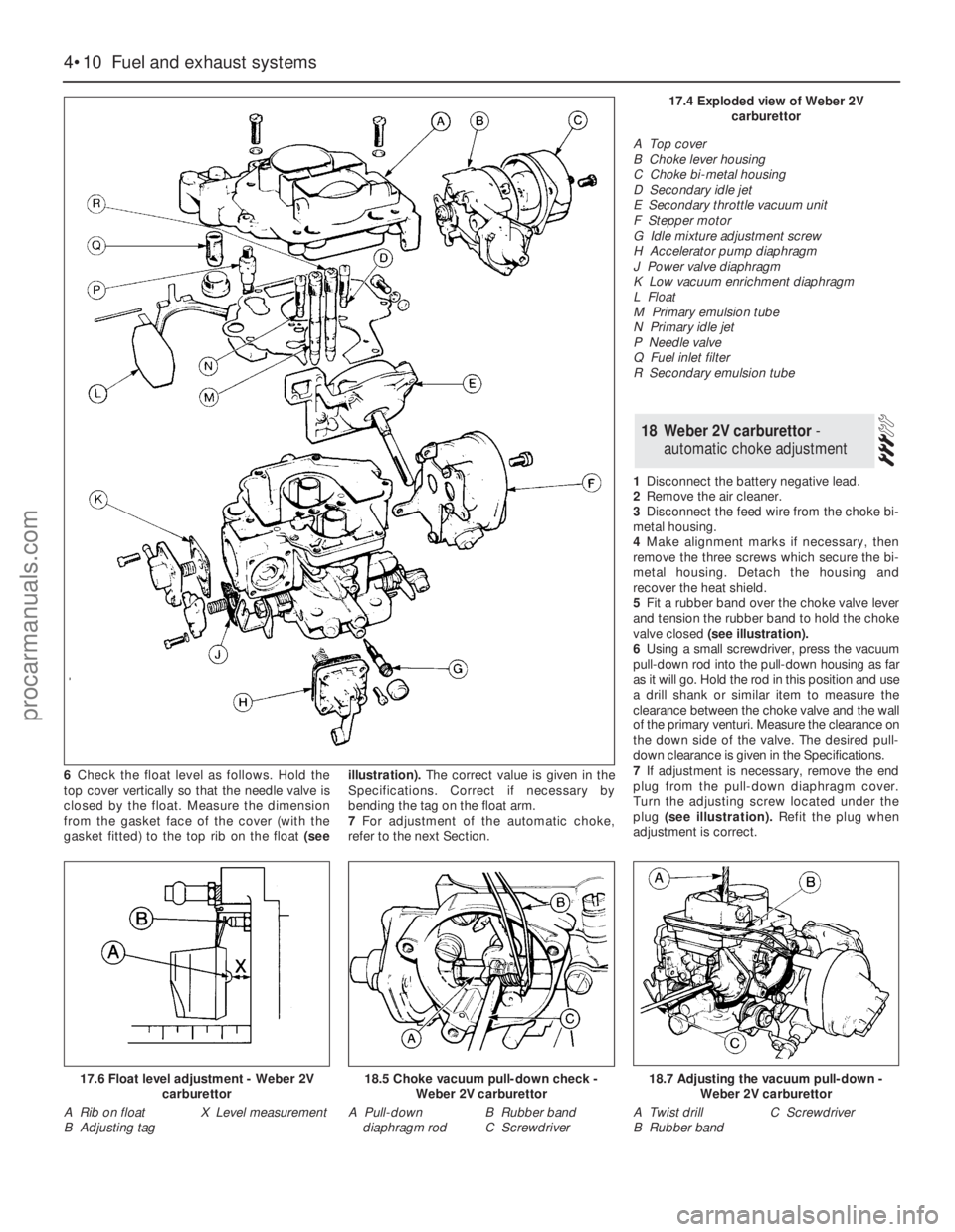
6Check the float level as follows. Hold the
top cover vertically so that the needle valve is
closed by the float. Measure the dimension
from the gasket face of the cover (with the
gasket fitted) to the top rib on the float(seeillustration).The correct value is given in the
Specifications. Correct if necessary by
bending the tag on the float arm.
7For adjustment of the automatic choke,
refer to the next Section.1Disconnect the battery negative lead.
2Remove the air cleaner.
3Disconnect the feed wire from the choke bi-
metal housing.
4Make alignment marks if necessary, then
remove the three screws which secure the bi-
metal housing. Detach thehousing and
recover the heat shield.
5Fit a rubber band over the choke valve lever
and tension the rubber band to hold the choke
valve closed(see illustration).
6Using a small screwdriver, press the vacuum
pull-down rod into the pull-down housing as far
as it will go. Hold the rod in this position and use
a drill shank or similar item to measure the
clearance between the choke valve and the wall
of the primary venturi. Measure the clearance on
the down side of the valve. The desired pull-
down clearance is given in the Specifications.
7If adjustment is necessary, remove the end
plug from the pull-down diaphragm cover.
Turn the adjusting screw located under the
plug (see illustration).Refit the plug when
adjustment is correct.
18Weber 2V carburettor -
automatic choke adjustment
4•10Fuel and exhaust systems
17.6 Float level adjustment - Weber 2V
carburettor
A Rib on float
B Adjusting tagX Level measurement
18.5 Choke vacuum pull-down check -
Weber 2V carburettor
A Pull-down
diaphragm rodB Rubber band
C Screwdriver
18.7 Adjusting the vacuum pull-down -
Weber 2V carburettor
A Twist drill
B Rubber bandC Screwdriver
17.4 Exploded view of Weber 2V
carburettor
A Top cover
B Choke lever housing
C Choke bi-metal housing
D Secondary idle jet
E Secondary throttle vacuum unit
F Stepper motor
G Idle mixture adjustment screw
H Accelerator pump diaphragm
J Power valve diaphragm
K Low vacuum enrichment diaphragm
L Float
M Primary emulsion tube
N Primary idle jet
P Needle valve
Q Fuel inlet filter
R Secondary emulsion tube
procarmanuals.com
Page 104 of 255
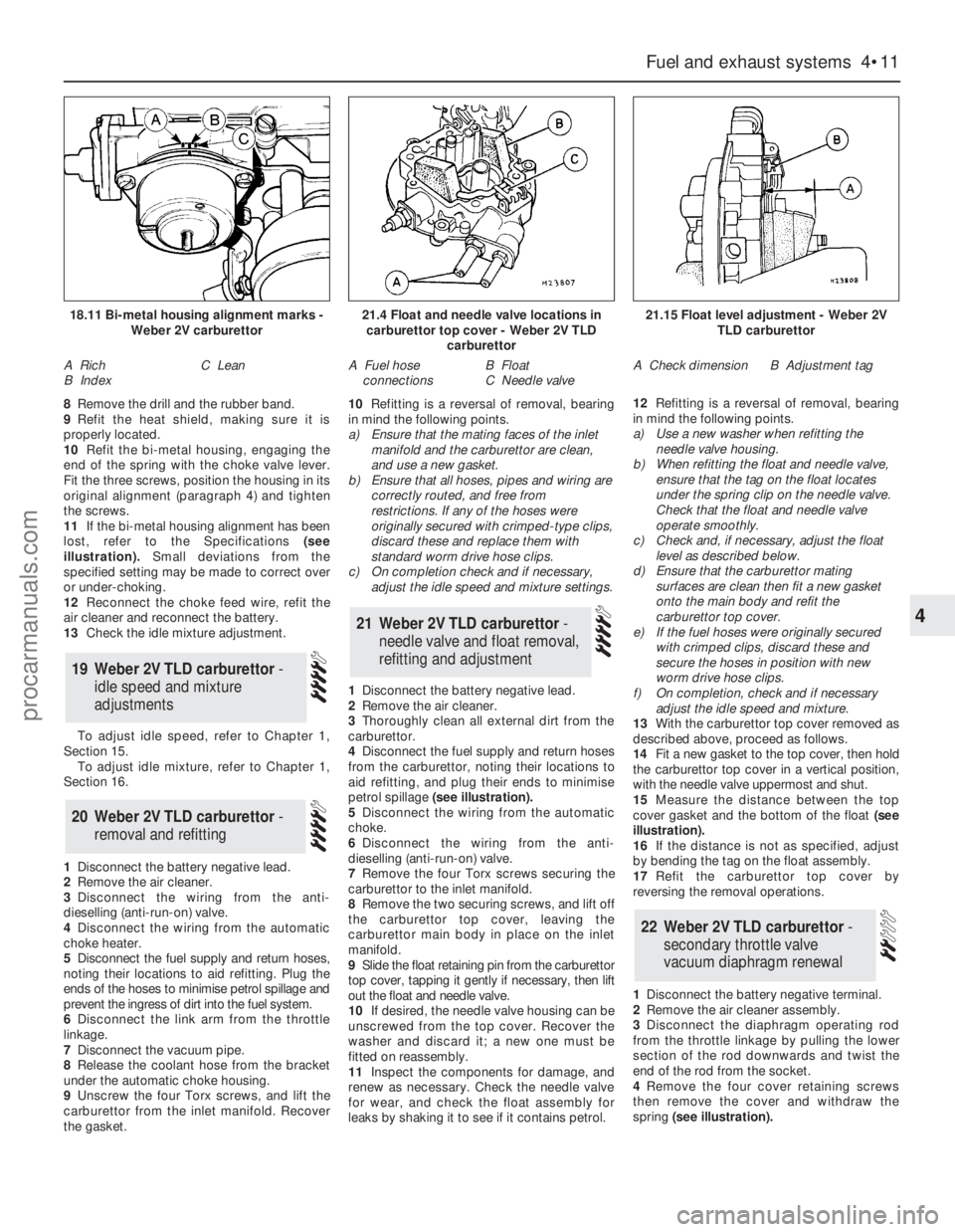
8Remove the drill and the rubber band.
9Refit the heat shield, making sure it is
properly located.
10Refit the bi-metal housing, engaging the
end of the spring with the choke valve lever.
Fit the three screws, position the housing in its
original alignment (paragraph 4) and tighten
the screws.
11If the bi-metal housing alignment has been
lost, refer to the Specifications(see
illustration).Small deviations from the
specified setting may be made to correct over
or under-choking.
12Reconnect the choke feed wire, refit the
air cleaner and reconnect the battery.
13Check the idle mixture adjustment.
To adjust idle speed, refer to Chapter 1,
Section 15.
To adjust idle mixture, refer to Chapter 1,
Section 16.
1Disconnect the battery negative lead.
2Remove the air cleaner.
3Disconnect the wiring from the anti-
dieselling (anti-run-on) valve.
4Disconnect the wiring from the automatic
choke heater.
5Disconnect the fuel supply and return hoses,
noting their locations to aid refitting. Plug the
ends of the hoses to minimise petrol spillage and
prevent the ingress of dirt into the fuel system.
6Disconnect the link arm from the throttle
linkage.
7Disconnect the vacuum pipe.
8Release the coolant hose from the bracket
under the automatic choke housing.
9Unscrew the four Torx screws, and lift the
carburettor from the inlet manifold. Recover
the gasket.10Refitting is a reversal of removal, bearing
in mind the following points.
a)Ensure that the mating faces of the inlet
manifold and the carburettor are clean,
and use a new gasket.
b)Ensure that all hoses, pipes and wiring are
correctly routed, and free from
restrictions. If any of the hoses were
originally secured with crimped-type clips,
discard these and replace them with
standard worm drive hose clips.
c)On completion check and if necessary,
adjust the idle speed and mixture settings.
1Disconnect the battery negative lead.
2Remove the air cleaner.
3Thoroughly clean all external dirt from the
carburettor.
4Disconnect the fuel supply and return hoses
from the carburettor, noting their locations to
aid refitting, and plug their ends to minimise
petrol spillage (see illustration).
5Disconnect the wiring from the automatic
choke.
6Disconnect the wiring from the anti-
dieselling (anti-run-on) valve.
7Remove the four Torx screws securing the
carburettor to the inlet manifold.
8Remove the two securing screws, and lift off
the carburettor top cover, leaving the
carburettor main body in place on the inlet
manifold.
9Slide the float retaining pin from the carburettor
top cover, tapping it gently if necessary, then lift
out the float and needle valve.
10If desired, the needle valve housing can be
unscrewed from the top cover. Recover the
washer and discard it; a new one must be
fitted on reassembly.
11Inspect the components for damage, and
renew as necessary. Check the needle valve
for wear, and check the float assembly for
leaks by shaking it to see if it contains petrol.12Refitting is a reversal of removal, bearing
in mind the following points.
a)Use a new washer when refitting the
needle valve housing.
b)When refitting the float and needle valve,
ensure that the tag on the float locates
under the spring clip on the needle valve.
Check that the float and needle valve
operate smoothly.
c)Check and, if necessary, adjust the float
level as described below.
d)Ensure that the carburettor mating
surfaces are clean then fit a new gasket
onto the main body and refit the
carburettor top cover.
e)If the fuel hoses were originally secured
with crimped clips, discard these and
secure the hoses in position with new
worm drive hose clips.
f)On completion, check and if necessary
adjust the idle speed and mixture.
13With the carburettor top cover removed as
described above, proceed as follows.
14Fit a new gasket to the top cover, then hold
the carburettor top cover in a vertical position,
with the needle valve uppermost and shut.
15Measure the distance between the top
cover gasket and the bottom of the float(see
illustration).
16If the distance is not as specified, adjust
by bending the tag on the float assembly.
17Refit the carburettor top cover by
reversing the removal operations.
1Disconnect the battery negative terminal.
2Remove the air cleaner assembly.
3Disconnect the diaphragm operating rod
from the throttle linkage by pulling the lower
section of the rod downwards and twist the
end of the rod from the socket.
4Remove the four cover retaining screws
then remove the cover and withdraw the
spring (see illustration).
22Weber 2V TLD carburettor -
secondary throttle valve
vacuum diaphragm renewal
21Weber 2V TLD carburettor -
needle valve and float removal,
refitting and adjustment
20Weber 2V TLD carburettor -
removal and refitting
19Weber 2V TLD carburettor -
idle speed and mixture
adjustments
Fuel and exhaust systems 4•11
4
18.11 Bi-metal housing alignment marks -
Weber 2V carburettor
A Rich
B IndexC Lean
21.4 Float and needle valve locations in
carburettor top cover - Weber 2V TLD
carburettor
A Fuel hose
connectionsB Float
C Needle valve
21.15 Float level adjustment - Weber 2V
TLD carburettor
A Check dimensionB Adjustment tag
procarmanuals.com
Page 105 of 255
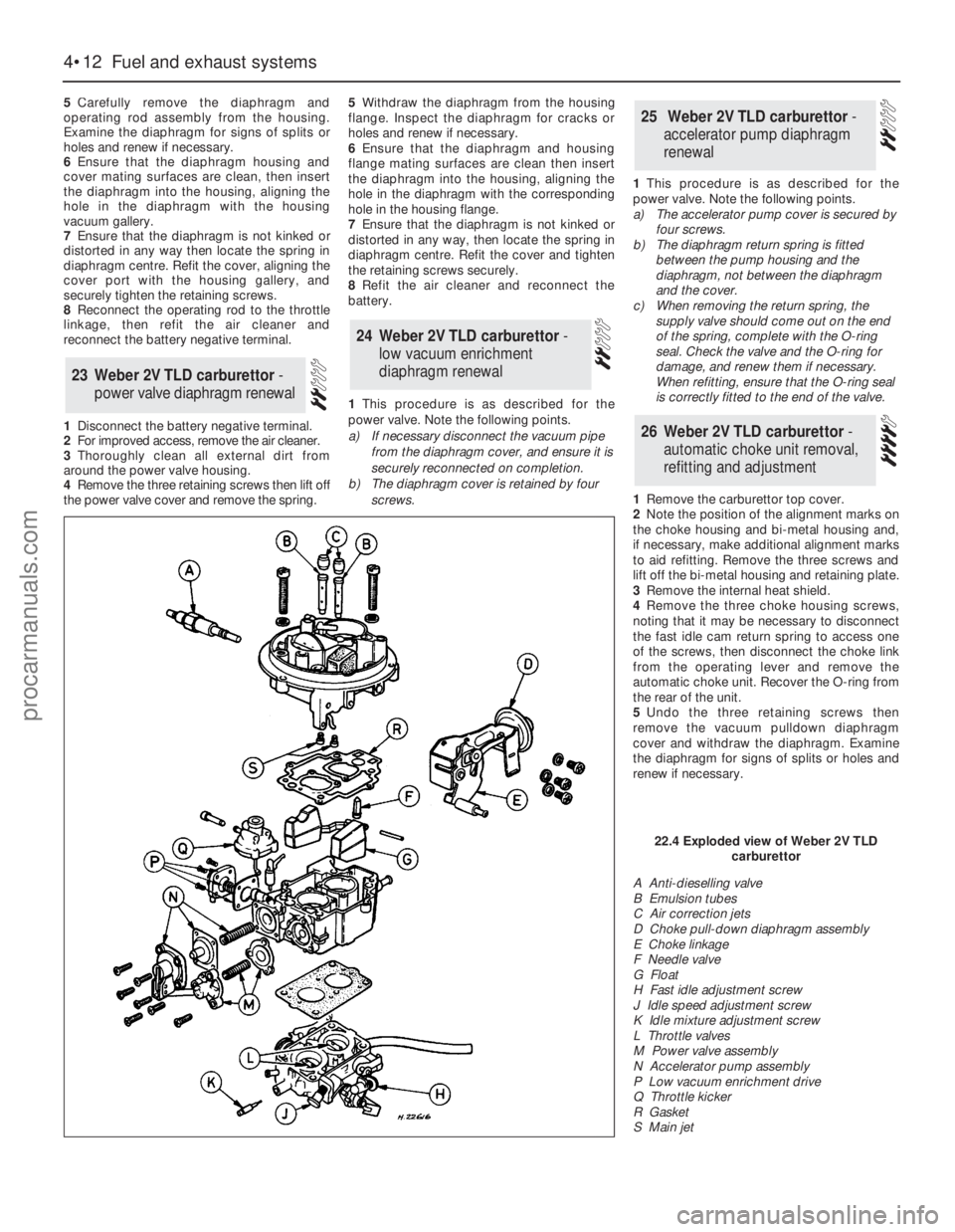
5Carefully remove the diaphragm and
operating rod assembly from the housing.
Examine the diaphragm for signs of splits or
holes and renew if necessary.
6Ensure that the diaphragm housing and
cover mating surfaces are clean, then insert
the diaphragm into the housing, aligning the
hole in the diaphragm with the housing
vacuum gallery.
7Ensure that the diaphragm is not kinked or
distorted in any way then locate the spring in
diaphragm centre. Refit the cover, aligning the
cover port with the housing gallery, and
securely tighten the retaining screws.
8Reconnect the operating rod to the throttle
linkage, then refit the air cleaner and
reconnect the battery negative terminal.
1Disconnect the battery negative terminal.
2For improved access, remove the air cleaner.
3Thoroughly clean all external dirt from
around the power valve housing.
4Remove the three retaining screws then lift off
the power valve cover and remove the spring.5Withdraw the diaphragm from the housing
flange. Inspect the diaphragm for cracks or
holes and renew if necessary.
6Ensure that the diaphragm and housing
flange mating surfaces are clean then insert
the diaphragm into the housing, aligning the
hole in the diaphragm with the corresponding
hole in the housing flange.
7Ensure that the diaphragm is not kinked or
distorted in any way, then locate the spring in
diaphragm centre. Refit the cover and tighten
the retaining screws securely.
8Refit the air cleaner and reconnect the
battery.
1This procedure is as describedfor the
power valve. Note the following points.
a)If necessary disconnect the vacuum pipe
from the diaphragm cover, and ensure it is
securely reconnected on completion.
b)The diaphragm cover is retained by four
screws.1This procedure is as described for the
power valve. Note the following points.
a)The accelerator pump cover is secured by
four screws.
b)The diaphragm return spring is fitted
between the pump housing and the
diaphragm, not between the diaphragm
and the cover.
c)When removing the return spring, the
supply valve should come out on the end
of the spring, complete with the O-ring
seal. Check the valve and the O-ring for
damage, and renew them if necessary.
When refitting, ensure that the O-ring seal
is correctly fitted to the end of the valve.
1Remove the carburettor top cover.
2Note the position of the alignment marks on
the choke housing and bi-metal housing and,
if necessary, make additional alignment marks
to aid refitting. Remove the three screws and
lift off the bi-metal housing and retaining plate.
3Remove the internal heat shield.
4Remove the three choke housing screws,
noting that it may be necessary to disconnect
the fast idle cam return spring to access one
of the screws, then disconnect the choke link
from the operating lever and remove the
automatic choke unit. Recover the O-ring from
the rear of the unit.
5 Undo the three retaining screws then
remove the vacuum pulldown diaphragm
cover and withdraw the diaphragm. Examine
the diaphragm for signs of splits or holes and
renew if necessary.
26Weber 2V TLD carburettor -
automatic choke unit removal,
refitting and adjustment
25Weber 2V TLD carburettor -
accelerator pump diaphragm
renewal
24Weber 2V TLD carburettor -
low vacuum enrichment
diaphragm renewal
23Weber 2V TLD carburettor -
power valve diaphragm renewal
4•12Fuel and exhaust systems
A Anti-dieselling valve
B Emulsion tubes
C Air correction jets
D Choke pull-down diaphragm assembly
E Choke linkage
F Needle valve
G Float
H Fast idle adjustment screw
J Idle speed adjustment screw
K Idle mixture adjustment screw
L Throttle valves
M Power valve assembly
N Accelerator pump assembly
P Low vacuum enrichment drive
Q Throttle kicker
R Gasket
S Main jet
22.4 Exploded view of Weber 2V TLD
carburettor
procarmanuals.com
Page 106 of 255
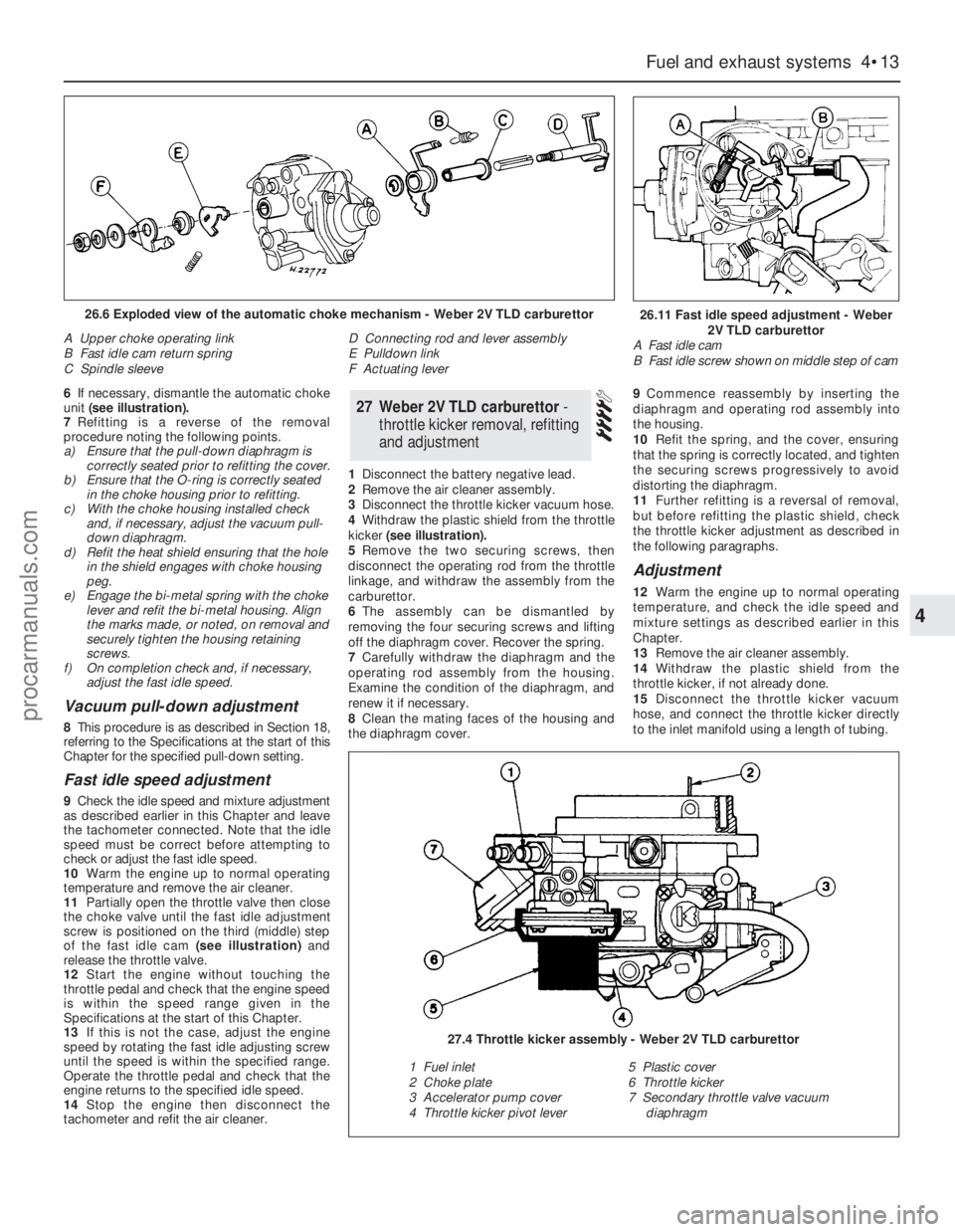
6If necessary, dismantle the automatic choke
unit (see illustration).
7Refitting is a reverse of the removal
procedure noting the following points.
a)Ensure that the pull-down diaphragm is
correctly seated prior to refitting the cover.
b)Ensure that the O-ring is correctly seated
in the choke housing prior to refitting.
c)With the choke housing installed check
and, if necessary, adjust the vacuum pull-
down diaphragm.
d)Refit the heat shield ensuring that the hole
in the shield engages with choke housing
peg.
e)Engage the bi-metal spring with the choke
lever and refit the bi-metal housing. Align
the marks made, or noted, on removal and
securely tighten the housing retaining
screws.
f)On completion check and, if necessary,
adjust the fast idle speed.
Vacuum pull-down adjustment
8This procedure is as described in Section 18,
referring to the Specifications at the start of this
Chapter for the specified pull-down setting.
Fast idle speed adjustment
9Check the idle speed and mixture adjustment
as described earlier in this Chapter and leave
the tachometer connected. Note that the idle
speed must be correct before attempting to
check or adjust the fast idle speed.
10Warm the engine up to normal operating
temperature and remove the air cleaner.
11Partially open the throttle valve then close
the choke valve until the fast idle adjustment
screw is positioned on the third (middle) step
of the fast idle cam(see illustration)and
release the throttle valve.
12Start the engine without touching the
throttle pedal and check that the engine speed
is within the speed range given in the
Specifications at the start of this Chapter.
13If this is not the case, adjust the engine
speed by rotating the fast idle adjusting screw
until the speed is within the specified range.
Operate the throttle pedal and check that the
engine returns to the specified idle speed.
14Stop the engine then disconnect the
tachometer and refit the air cleaner.1Disconnect the battery negative lead.
2Remove the air cleaner assembly.
3Disconnect the throttle kicker vacuum hose.
4Withdraw the plastic shield from the throttle
kicker(see illustration).
5Remove the two securing screws, then
disconnect the operating rod from the throttle
linkage, and withdraw the assembly from the
carburettor.
6The assembly can be dismantled by
removing the four securing screws and lifting
off the diaphragm cover. Recover the spring.
7Carefully withdraw the diaphragm and the
operating rod assembly from the housing.
Examine the condition of the diaphragm, and
renew it if necessary.
8Clean the mating faces of the housing and
the diaphragm cover.9Commence reassembly by inserting the
diaphragm and operating rod assembly into
the housing.
10Refit the spring, and the cover, ensuring
that the spring is correctly located, and tighten
the securing screws progressively to avoid
distorting the diaphragm.
11Further refitting is a reversal of removal,
but before refitting the plastic shield, check
the throttle kicker adjustment as described in
the following paragraphs.
Adjustment
12Warm the engine up to normal operating
temperature, and check the idle speed and
mixture settings as described earlier in this
Chapter.
13Remove the air cleaner assembly.
14Withdraw the plastic shield from the
throttle kicker, if not already done.
15Disconnect the throttle kicker vacuum
hose, and connect the throttle kicker directly
to the inlet manifold using a length of tubing.
27Weber 2V TLD carburettor -
throttle kicker removal, refitting
and adjustment
Fuel and exhaust systems 4•13
4
26.11 Fast idle speed adjustment - Weber
2V TLD carburettor
A Fast idle cam
B Fast idle screw shown on middle step of cam26.6 Exploded view of the automatic choke mechanism - Weber 2V TLD carburettor
A Upper choke operating link
B Fast idle cam return spring
C Spindle sleeveD Connecting rod and lever assembly
E Pulldown link
F Actuating lever
27.4 Throttle kicker assembly - Weber 2V TLD carburettor
1 Fuel inlet
2 Choke plate
3 Accelerator pump cover
4 Throttle kicker pivot lever5 Plastic cover
6 Throttle kicker
7 Secondary throttle valve vacuum
diaphragm
procarmanuals.com
Page 107 of 255
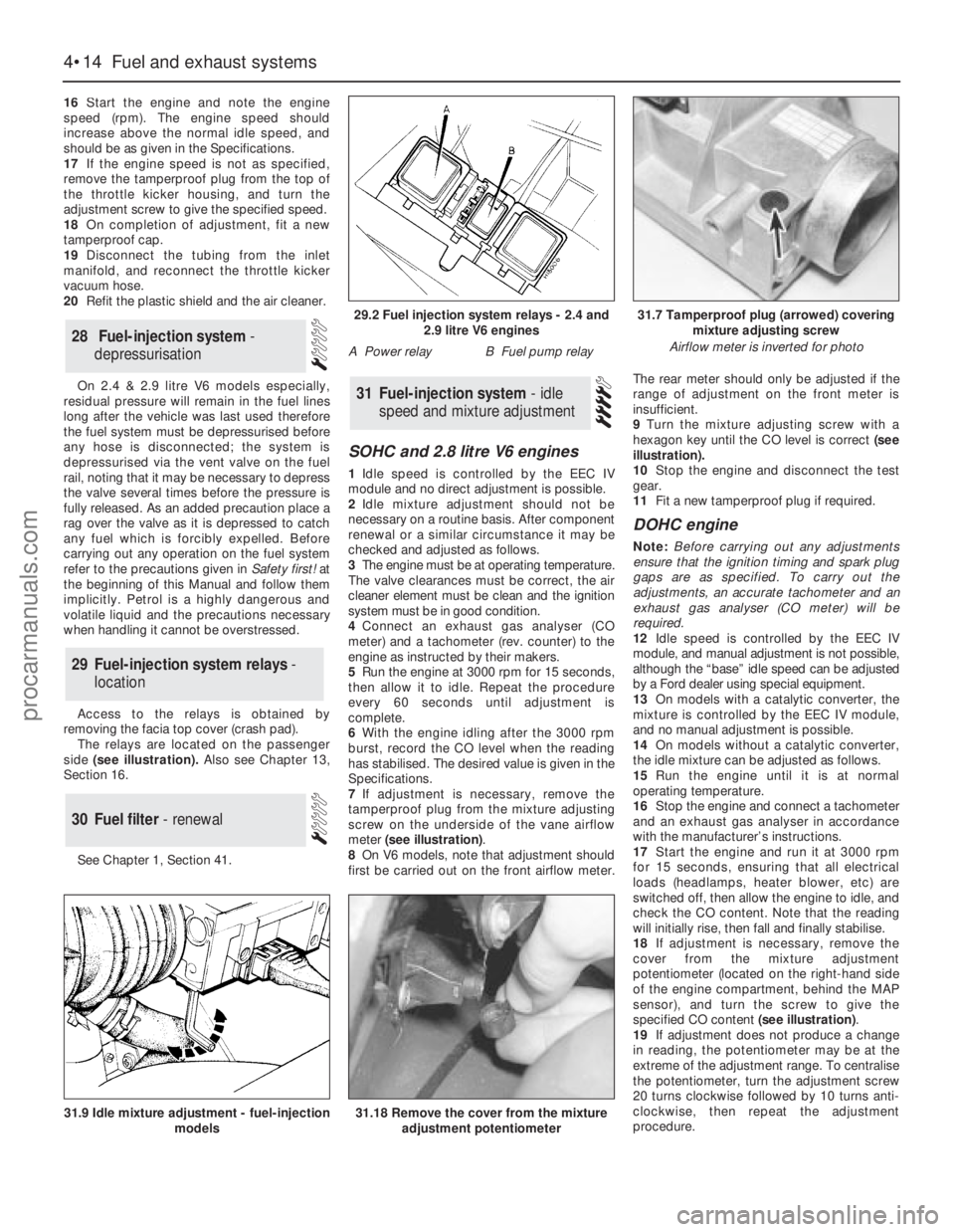
16Start the engine and note the engine
speed (rpm). The engine speed should
increase above the normal idle speed, and
should be as given in the Specifications.
17If the engine speed is not as specified,
remove the tamperproof plug from the top of
the throttle kicker housing, and turn the
adjustment screw to give the specified speed.
18On completion of adjustment, fit a new
tamperproof cap.
19Disconnect the tubing from the inlet
manifold, and reconnect the throttle kicker
vacuum hose.
20Refit the plastic shield and the air cleaner.
On 2.4 & 2.9 litre V6 models especially,
residual pressure will remain in the fuel lines
long after the vehicle was last used therefore
the fuel system must be depressurised before
any hose is disconnected; the system is
depressurised via the vent valve on the fuel
rail, noting that it may be necessary to depress
the valve several times before the pressure is
fully released. As an added precaution place a
rag over the valve as it is depressed to catch
any fuel which is forcibly expelled. Before
carrying out any operation on the fuel system
refer to the precautions given in Safety first! at
the beginning of this Manual and follow them
implicitly. Petrol is a highly dangerous and
volatile liquid and the precautions necessary
when handling it cannot be overstressed.
Access to the relays is obtained by
removing the facia top cover (crash pad).
The relays are located on the passenger
side(see illustration). Also see Chapter 13,
Section 16.
See Chapter 1, Section 41.
SOHC and 2.8 litre V6 engines
1Idle speed is controlled by the EEC IV
module and no direct adjustment is possible.
2Idle mixture adjustment should not be
necessary on a routine basis. After component
renewal or a similar circumstance it may be
checked and adjusted as follows.
3The engine must be at operating temperature.
The valve clearances must be correct, the air
cleaner element must be clean and the ignition
system must be in good condition.
4Connect an exhaust gas analyser (CO
meter) and a tachometer (rev. counter) to the
engine as instructed by their makers.
5Run the engine at 3000 rpm for 15 seconds,
then allow it to idle. Repeat the procedure
every 60 seconds until adjustment is
complete.
6With the engine idling after the 3000 rpm
burst, record the CO level when the reading
has stabilised. The desired value is given in the
Specifications.
7If adjustment is necessary, remove the
tamperproof plug from the mixture adjusting
screw on the underside of the vane airflow
meter (see illustration).
8On V6 models, note that adjustment should
first be carried out on the front airflow meter.The rear meter should only be adjusted if the
range of adjustment on the front meter is
insufficient.
9Turn the mixture adjusting screw with a
hexagon key until the CO level is correct (see
illustration).
10Stop the engine and disconnect the test
gear.
11Fit a new tamperproof plug if required.
DOHC engine
Note: Before carrying out any adjustments
ensure that the ignition timing and spark plug
gaps are as specified. To carry out the
adjustments, an accurate tachometer and an
exhaust gas analyser (CO meter) will be
required.
12Idle speed is controlled by the EEC IV
module, and manual adjustment is not possible,
although the “base” idle speed can be adjusted
by a Ford dealer using special equipment.
13On models with a catalytic converter, the
mixture is controlled by the EEC IV module,
and no manual adjustment is possible.
14On models without a catalytic converter,
the idle mixture can be adjusted as follows.
15Run the engine until it is at normal
operating temperature.
16Stop the engine and connect a tachometer
and an exhaust gas analyser in accordance
with the manufacturer’s instructions.
17Start the engine and run it at 3000 rpm
for 15 seconds, ensuring that all electrical
loads (headlamps, heater blower, etc) are
switched off, then allow the engine to idle, and
check the CO content. Note that the reading
will initially rise, then fall and finally stabilise.
18If adjustment is necessary, remove the
cover from the mixture adjustment
potentiometer (located on the right-hand side
of the engine compartment, behind the MAP
sensor), and turn the screw to give the
specified CO content (see illustration).
19If adjustment does not produce a change
in reading, the potentiometer may be at the
extreme of the adjustment range. To centralise
the potentiometer, turn the adjustment screw
20 turns clockwise followed by 10 turns anti-
clockwise, then repeat the adjustment
procedure.
31Fuel-injection system - idle
speed and mixture adjustment
30Fuel filter - renewal
29Fuel-injection system relays -
location
28Fuel-injection system -
depressurisation
4•14Fuel and exhaust systems
31.18 Remove the cover from the mixture
adjustment potentiometer31.9 Idle mixture adjustment - fuel-injection
models
29.2 Fuel injection system relays - 2.4 and
2.9 litre V6 engines
A Power relayB Fuel pump relay
31.7 Tamperproof plug (arrowed) covering
mixture adjusting screw
Airflow meter is inverted for photo
procarmanuals.com
Page 108 of 255
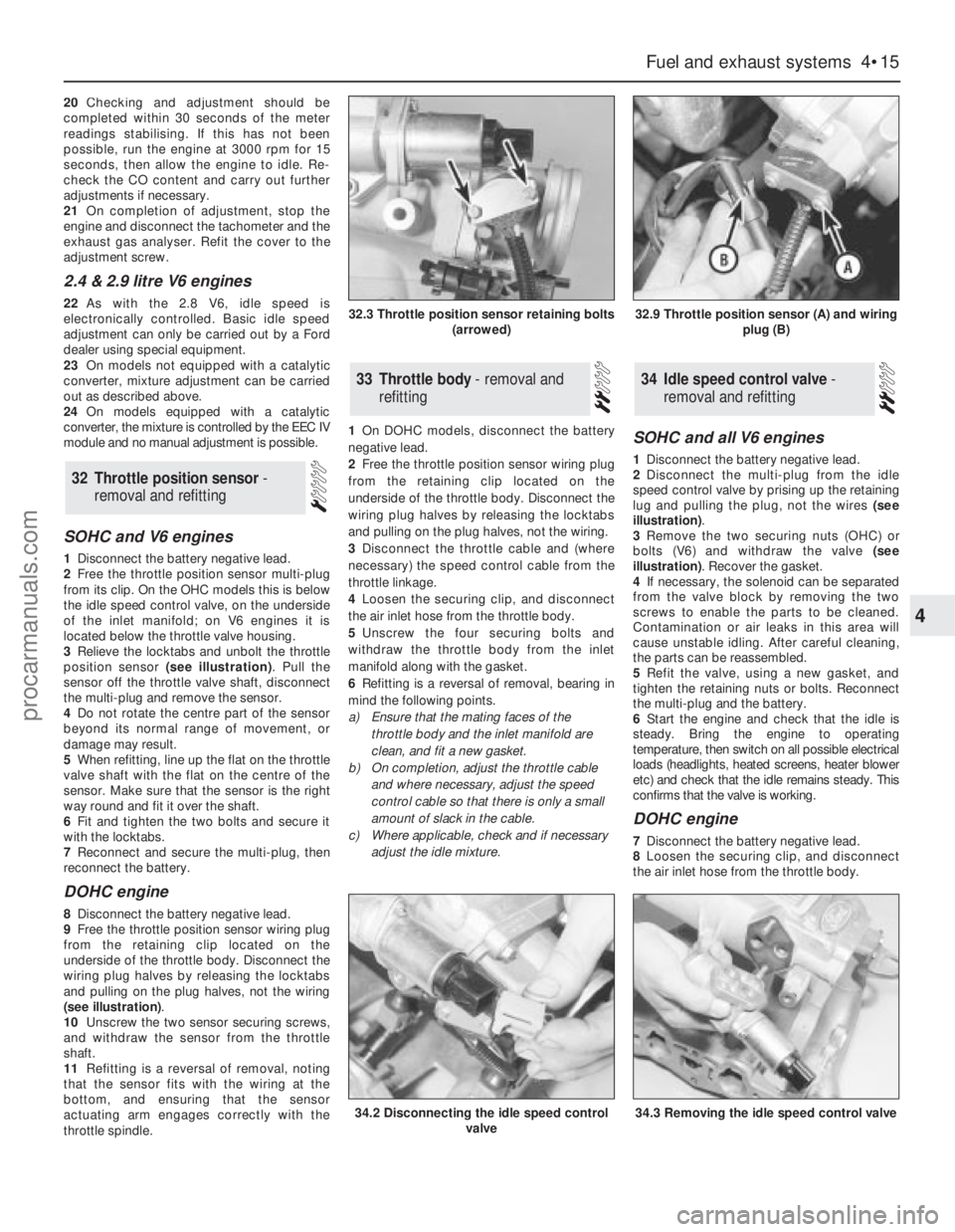
20Checking and adjustment should be
completed within 30 seconds of the meter
readings stabilising. If this has not been
possible, run the engine at 3000 rpm for 15
seconds, then allow the engine to idle. Re-
check the CO content and carry out further
adjustments if necessary.
21On completion of adjustment, stop the
engine and disconnect the tachometer and the
exhaust gas analyser. Refit the cover to the
adjustment screw.
2.4 & 2.9 litre V6 engines
22As with the 2.8 V6, idle speed is
electronically controlled. Basic idle speed
adjustment can only be carried out by a Ford
dealer using special equipment.
23On models not equipped with a catalytic
converter, mixture adjustment can be carried
out as described above.
24On models equipped with a catalytic
converter, the mixture is controlled by the EEC IV
module and no manual adjustment is possible.
SOHC and V6 engines
1Disconnect the battery negative lead.
2Free the throttle position sensor multi-plug
from its clip. On the OHCmodels this is below
the idle speed control valve, on the underside
of the inlet manifold; on V6 engines it is
located below the throttle valve housing.
3Relieve the locktabs and unbolt the throttle
position sensor (see illustration). Pull the
sensor off the throttle valve shaft, disconnect
the multi-plug and remove the sensor.
4Do not rotate the centre part of the sensor
beyond its normal range of movement, or
damage may result.
5When refitting, line up the flat on the throttle
valve shaft with the flat on the centre of the
sensor. Make sure that the sensor is the right
way round and fit it over the shaft.
6Fit and tighten the two bolts and secure it
with the locktabs.
7Reconnect and secure the multi-plug, then
reconnect the battery.
DOHC engine
8Disconnect the battery negative lead.
9Free the throttle position sensor wiring plug
from the retaining clip located on the
underside of the throttle body. Disconnect the
wiring plug halves by releasing the locktabs
and pulling on the plug halves, not the wiring
(see illustration).
10Unscrew the two sensor securing screws,
and withdraw the sensor from the throttle
shaft.
11Refitting is a reversal of removal, noting
that the sensor fits with the wiring at the
bottom, and ensuring that the sensor
actuating arm engages correctly with the
throttle spindle.1On DOHC models, disconnect the battery
negative lead.
2Free the throttle position sensor wiring plug
from the retaining clip located on the
underside of the throttle body. Disconnect the
wiring plug halves by releasing the locktabs
and pulling on the plug halves, not the wiring.
3Disconnect the throttle cable and (where
necessary) the speed control cable from the
throttle linkage.
4Loosen the securing clip, and disconnect
the air inlet hose from the throttle body.
5Unscrew the four securing bolts and
withdraw the throttle body from the inlet
manifold along with the gasket.
6Refitting is a reversal of removal, bearing in
mind the following points.
a)Ensure that the mating faces of the
throttle body and the inlet manifold are
clean, and fit a new gasket.
b)On completion, adjust the throttle cable
and where necessary, adjust the speed
control cable so that there is only a small
amount of slack in the cable.
c)Where applicable, check and if necessary
adjust the idle mixture.
SOHC and all V6 engines
1Disconnect the battery negative lead.
2Disconnect the multi-plug from the idle
speed control valve by prising up the retaining
lug and pulling the plug, not the wires (see
illustration).
3Remove the two securing nuts (OHC) or
bolts (V6) and withdraw the valve (see
illustration). Recover the gasket.
4If necessary, the solenoid can be separated
from the valve block by removing the two
screws to enable the parts to be cleaned.
Contamination or air leaks in this area will
cause unstable idling. After careful cleaning,
the parts can be reassembled.
5Refit the valve, using a new gasket, and
tighten the retaining nuts or bolts. Reconnect
the multi-plug and the battery.
6Start the engine and check that the idle is
steady. Bring the engine to operating
temperature, then switch on all possible electrical
loads (headlights, heated screens, heater blower
etc) and check that the idle remains steady. This
confirms that the valve is working.
DOHC engine
7Disconnect the battery negative lead.
8Loosen the securing clip, and disconnect
the air inlet hose from the throttle body.
34Idle speed control valve -
removal and refitting33Throttle body - removal and
refitting
32Throttle position sensor -
removal and refitting
Fuel and exhaust systems 4•15
4
32.3 Throttle position sensor retaining bolts
(arrowed)32.9 Throttle position sensor (A) and wiring
plug (B)
34.2 Disconnecting the idle speed control
valve34.3 Removing the idle speed control valve
procarmanuals.com
Page 109 of 255
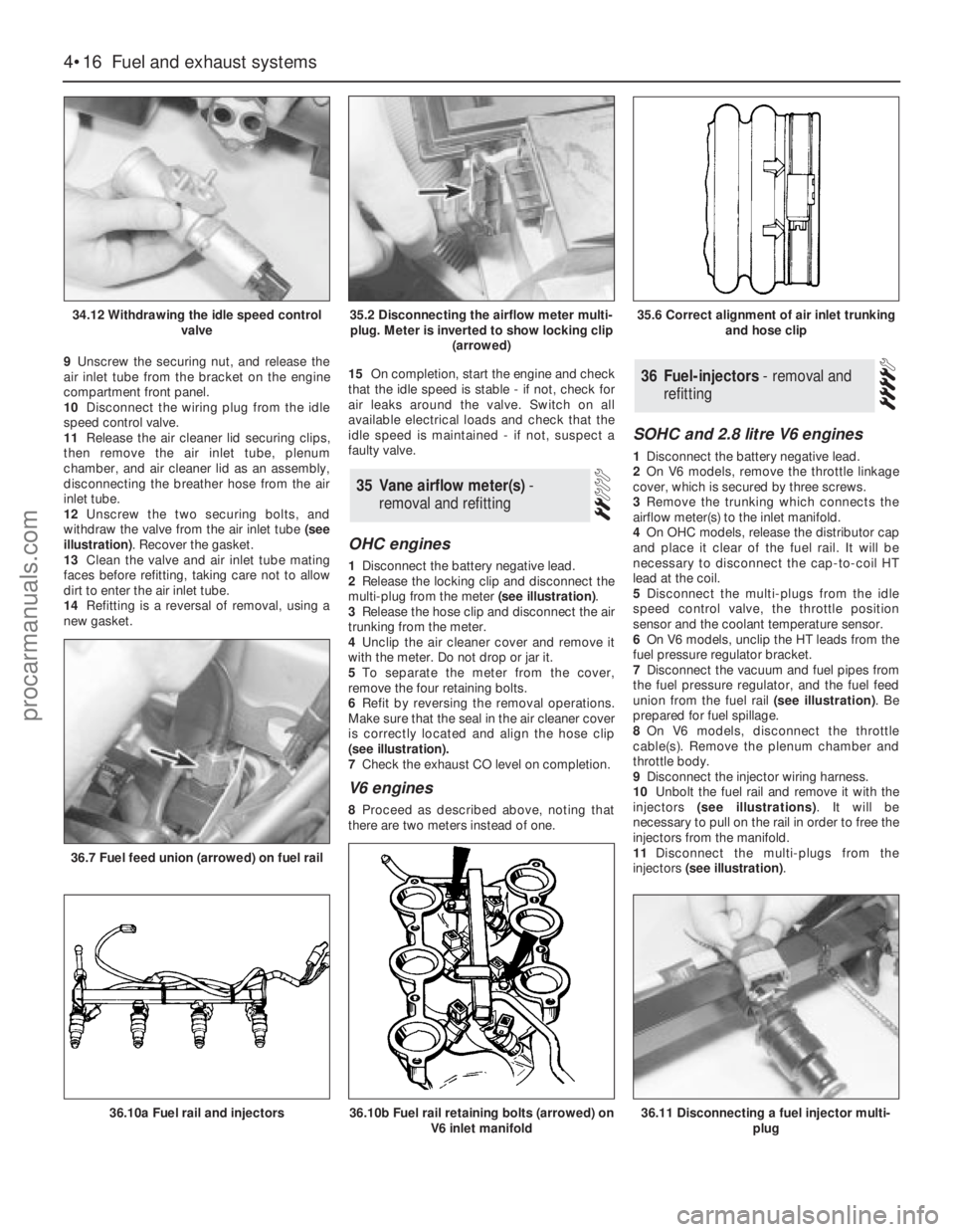
9Unscrew the securing nut, and release the
air inlet tube from the bracket on the engine
compartment front panel.
10Disconnect the wiring plug from the idle
speed control valve.
11Release the air cleaner lid securing clips,
then remove the air inlet tube, plenum
chamber, and air cleaner lid as an assembly,
disconnecting the breather hose from the air
inlet tube.
12Unscrew the two securing bolts, and
withdraw the valve from the air inlet tube (see
illustration). Recover the gasket.
13Clean the valve and air inlet tube mating
faces before refitting, taking care not to allow
dirt to enter the air inlet tube.
14Refitting is a reversal of removal, using a
new gasket.15On completion, start the engine and check
that the idle speed is stable - if not, check for
air leaks around the valve. Switch on all
available electrical loads and check that the
idle speed is maintained - if not, suspect a
faulty valve.
OHC engines
1Disconnect the battery negative lead.
2Release the locking clip and disconnect the
multi-plug from the meter (see illustration).
3Release the hose clip and disconnect the air
trunking from the meter.
4Unclip the air cleaner cover and remove it
with the meter. Do not drop or jar it.
5To separate the meter from the cover,
remove the four retaining bolts.
6Refit by reversing the removal operations.
Make sure that the seal in the air cleaner cover
is correctly located and align the hose clip
(seeillustration).
7Check the exhaust CO level on completion.
V6 engines
8Proceed as described above, noting that
there are two meters instead of one.
SOHC and 2.8 litre V6 engines
1Disconnect the battery negative lead.
2On V6 models, remove the throttle linkage
cover, which is secured by three screws.
3Remove the trunking which connects the
airflow meter(s) to the inlet manifold.
4On OHCmodels, release the distributor cap
and place it clear of the fuel rail. It will be
necessary to disconnect the cap-to-coil HT
lead at the coil.
5Disconnect the multi-plugs from the idle
speed control valve, the throttle position
sensor and the coolant temperature sensor.
6On V6 models, unclip the HT leads from the
fuel pressure regulator bracket.
7Disconnect the vacuum and fuel pipes from
the fuel pressure regulator, and the fuel feed
union from the fuel rail (see illustration). Be
prepared for fuel spillage.
8On V6 models, disconnect the throttle
cable(s). Remove the plenum chamber and
throttle body.
9Disconnect the injector wiring harness.
10Unbolt the fuel rail and remove it with the
injectors (see illustrations). It will be
necessary to pull on the rail in order to free the
injectors from the manifold.
11Disconnect the multi-plugs from the
injectors (see illustration).
36Fuel-injectors - removal and
refitting
35Vane airflow meter(s) -
removal and refitting
4•16Fuel and exhaust systems
34.12 Withdrawing the idle speed control
valve
36.7 Fuel feed union (arrowed) on fuel rail
36.10a Fuel rail and injectors36.10b Fuel rail retaining bolts (arrowed) on
V6 inlet manifold36.11 Disconnecting a fuel injector multi-
plug
35.2 Disconnecting the airflow meter multi-
plug. Meter is inverted to show locking clip
(arrowed)35.6 Correct alignment of air inlet trunking
and hose clip
procarmanuals.com
Page 110 of 255
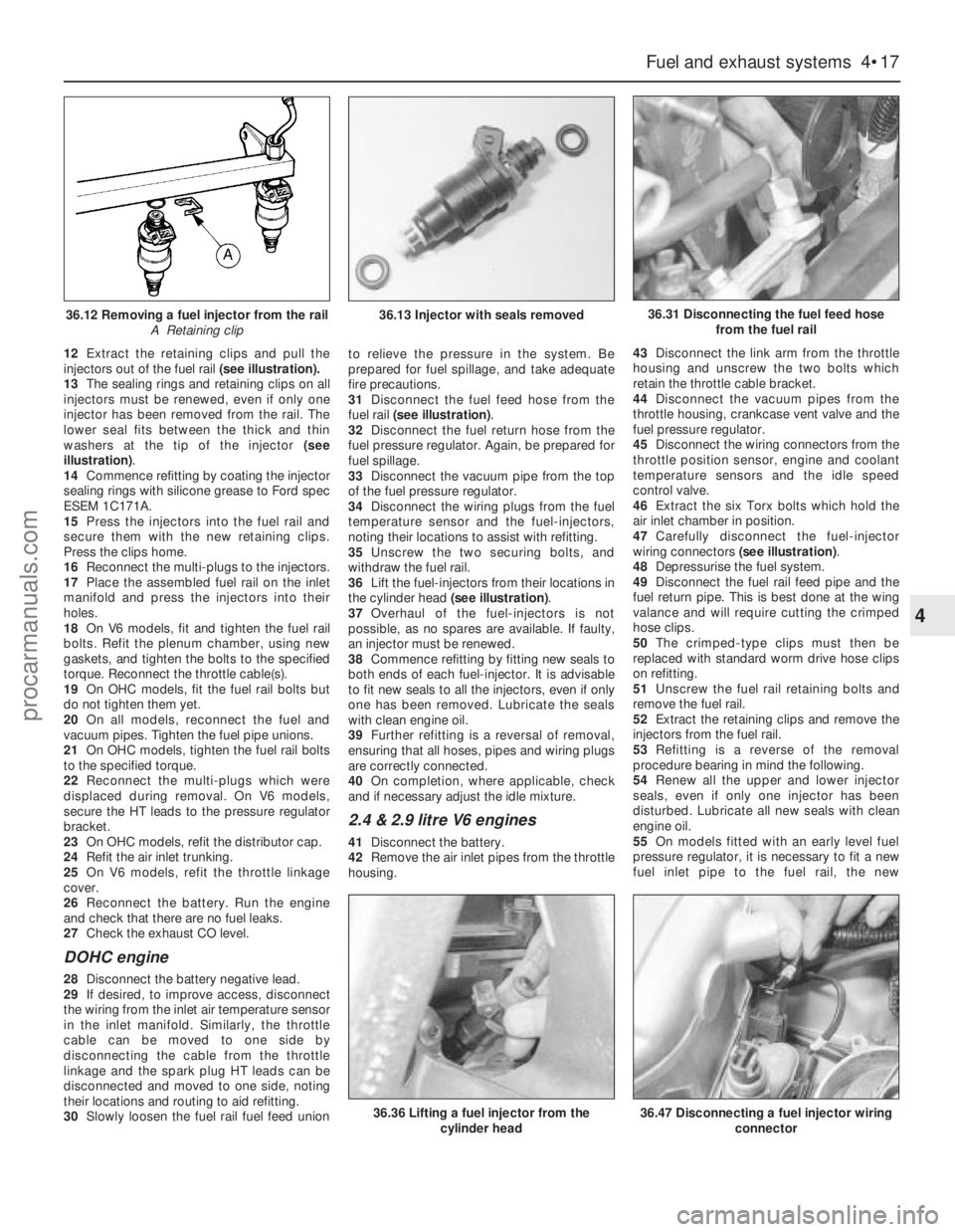
12Extract the retaining clips and pull the
injectors out of the fuel rail(see illustration).
13The sealing rings and retaining clips on all
injectors must be renewed, even if only one
injector has been removed from the rail. The
lower seal fits between the thick and thin
washers at the tip of the injector (see
illustration).
14Commence refitting by coating the injector
sealing rings with silicone grease to Ford spec
ESEM 1C171A.
15Press the injectors into the fuel rail and
secure them with the new retaining clips.
Press the clips home.
16Reconnect the multi-plugs to the injectors.
17Place the assembled fuel rail on the inlet
manifold and press the injectors into their
holes.
18On V6 models, fit and tighten the fuel rail
bolts. Refit the plenum chamber, using new
gaskets, and tighten the bolts to the specified
torque. Reconnect the throttle cable(s).
19On OHCmodels, fit the fuel rail bolts but
do not tighten them yet.
20On all models, reconnect the fuel and
vacuum pipes. Tighten the fuel pipe unions.
21On OHCmodels, tighten the fuel rail bolts
to the specified torque.
22Reconnect the multi-plugs which were
displaced during removal. On V6 models,
secure the HT leads to the pressure regulator
bracket.
23On OHCmodels, refit the distributor cap.
24Refit the air inlet trunking.
25On V6 models, refit the throttle linkage
cover.
26Reconnect the battery. Run the engine
and check that there are no fuel leaks.
27Check the exhaust CO level.
DOHC engine
28Disconnect the battery negative lead.
29If desired, to improve access, disconnect
the wiring from the inlet air temperature sensor
in the inlet manifold. Similarly, the throttle
cable can be moved to one side by
disconnecting the cable from the throttle
linkage and the spark plug HT leads can be
disconnected and moved to one side, noting
their locations and routing to aid refitting.
30Slowly loosen the fuel rail fuel feed unionto relieve the pressure in the system. Be
prepared for fuel spillage, and take adequate
fire precautions.
31Disconnect the fuel feed hose from the
fuel rail (see illustration).
32Disconnect the fuel return hose from the
fuel pressure regulator. Again, be prepared for
fuel spillage.
33Disconnect the vacuum pipe from the top
of the fuel pressure regulator.
34Disconnect the wiring plugs from the fuel
temperature sensor and the fuel-injectors,
noting their locations to assist with refitting.
35Unscrew the two securing bolts, and
withdraw the fuel rail.
36Lift the fuel-injectors from their locations in
the cylinder head (see illustration).
37Overhaul of the fuel-injectors is not
possible, as no spares are available. If faulty,
an injector must be renewed.
38Commence refitting by fitting new seals to
both ends of each fuel-injector. It is advisable
to fit new seals to all the injectors, even if only
one has been removed. Lubricate the seals
with clean engine oil.
39Further refitting is a reversal of removal,
ensuring that all hoses, pipes and wiring plugs
are correctly connected.
40On completion, where applicable, check
and if necessary adjust the idle mixture.
2.4 & 2.9 litre V6 engines
41Disconnect the battery.
42Remove the air inlet pipes from the throttle
housing.43Disconnect the link arm from the throttle
housing and unscrew the two bolts which
retain the throttle cable bracket.
44Disconnect the vacuum pipes from the
throttle housing, crankcase vent valve and the
fuel pressure regulator.
45Disconnect the wiring connectors from the
throttle position sensor, engine and coolant
temperature sensors and the idle speed
control valve.
46Extract the six Torx bolts which hold the
air inlet chamber in position.
47Carefully disconnect the fuel-injector
wiring connectors (see illustration).
48Depressurise the fuel system.
49Disconnect the fuel rail feed pipe and the
fuel return pipe. This is best done at the wing
valance and will require cutting the crimped
hose clips.
50The crimped-type clips must then be
replaced with standard worm drive hose clips
on refitting.
51Unscrew the fuel rail retaining bolts and
remove the fuel rail.
52Extract the retaining clips and remove the
injectors from the fuel rail.
53Refitting is a reverse of the removal
procedure bearing in mind the following.
54Renew all the upper and lower injector
seals, even if only one injector has been
disturbed. Lubricate all new seals with clean
engine oil.
55On models fitted with an early level fuel
pressure regulator, it is necessary to fit a new
fuel inlet pipe to the fuel rail, the new
Fuel and exhaust systems 4•17
4
36.12 Removing a fuel injector from the rail
A Retaining clip36.13 Injector with seals removed36.31 Disconnecting the fuel feed hose
from the fuel rail
36.36 Lifting a fuel injector from the
cylinder head36.47 Disconnecting a fuel injector wiring
connector
procarmanuals.com